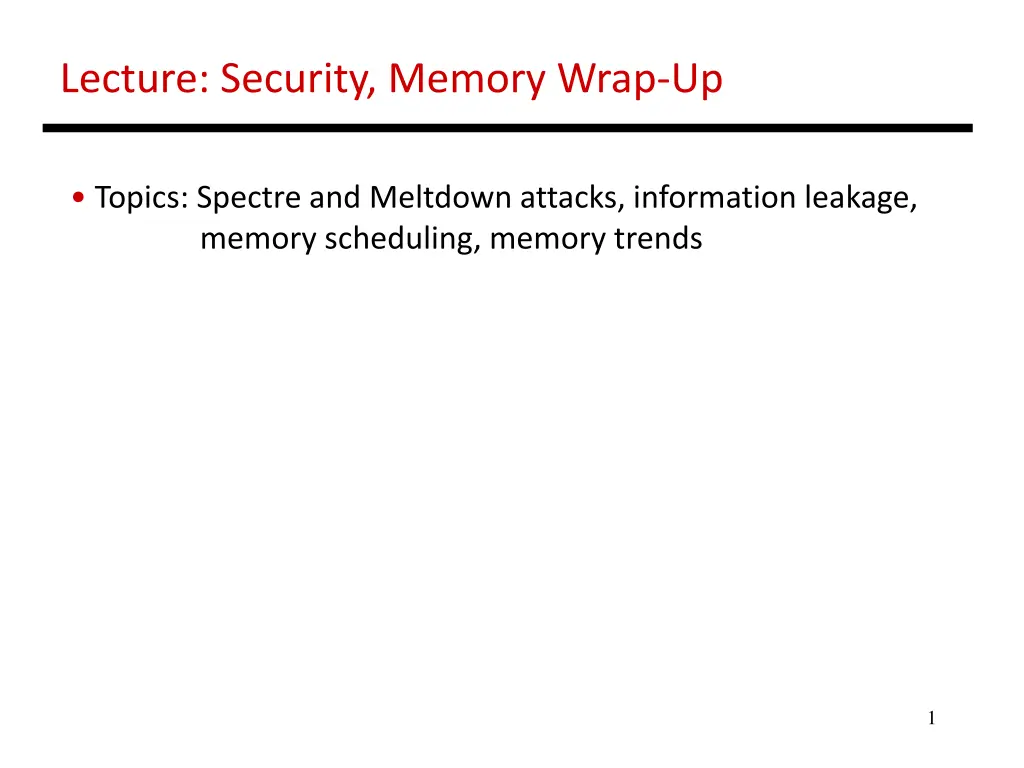
Security and Memory Wrap-Up: Spectre, Meltdown Attacks, Information Leakage
Explore the conclusion of Security and Memory topics covering Spectre and Meltdown attacks, information leakage, memory scheduling, and trends. Understand the intricacies of Meltdown and Spectre attacks, hardware security measures, address mapping policies, and memory scheduling policies.
Download Presentation

Please find below an Image/Link to download the presentation.
The content on the website is provided AS IS for your information and personal use only. It may not be sold, licensed, or shared on other websites without obtaining consent from the author. If you encounter any issues during the download, it is possible that the publisher has removed the file from their server.
You are allowed to download the files provided on this website for personal or commercial use, subject to the condition that they are used lawfully. All files are the property of their respective owners.
The content on the website is provided AS IS for your information and personal use only. It may not be sold, licensed, or shared on other websites without obtaining consent from the author.
E N D
Presentation Transcript
Lecture: Security, Memory Wrap-Up Topics: Spectre and Meltdown attacks, information leakage, memory scheduling, memory trends 1
Meltdown Attacker code Fill the cache with your own data X lw R1 [illegal address] lw [R1] Scan through X and record time per access 2
Spectre: Variant 1 x is controlled by attacker Thanks to bpred, x can be anything array1[ ] is the secret if (x < array1_size) y = array2[ array1[x] ]; Victim Code Access pattern of array2[ ] betrays the secret 3
Spectre: Variant 2 Victim code R1 (from attacker) R2 some secret Label0: if ( ) Attacker code Label0: if (1) Label1: Victim code Label1: lw [R2] 4
Hardware Security Several types of attacks: physical access to hardware, compromised OS, untrusted co-scheduled applications Defenses include: hardware permission checks, encryption, microarchitecture partitions, signature checks Information leakage still unresolved exploited by Meltdown, Spectre, and many subsequent attacks 5
Address Mapping Policies Consecutive cache lines can be placed in the same row to boost row buffer hit rates Consecutive cache lines can be placed in different ranks to boost parallelism Example address mapping policies: row:rank:bank:channel:column:blkoffset row:column:rank:bank:channel:blkoffset 6
Reads and Writes A single bus is used for reads and writes The bus direction must be reversed when switching between reads and writes; this takes time and leads to bus idling Hence, writes are performed in bursts; a write buffer stores pending writes until a high water mark is reached Writes are drained until a low water mark is reached 7
Scheduling Policies FCFS: Issue the first read or write in the queue that is ready for issue First Ready - FCFS: First issue row buffer hits if you can Close page -- early precharge Stall Time Fair: First issue row buffer hits, unless other threads are being neglected 8
Error Correction For every 64-bit word, can add an 8-bit code that can detect two errors and correct one error; referred to as SECDED single error correct double error detect A rank is now made up of 9 x8 chips, instead of 8 x8 chips Stronger forms of error protection exist: a system is chipkill correct if it can handle an entire DRAM chip failure 9
Modern Memory Systems I .. .. .. .. .. .. PROC 4 DDR4 channels 72-bit data channels 1200 MHz channels 1-2 DIMMs/channel 1-4 ranks/channel .. .. 10
Modern Memory Systems II .. .. SMB PROC .. .. The link into the processor is narrow and high frequency The Scalable Memory Buffer chip is a router that connects to multiple DDR channels (wide and slow) Boosts processor pin bandwidth and memory capacity More expensive, high power 11
Future Memory Trends Processor pin count is not increasing; can t add much load per wire; SMB-like approaches help address the capacity/bw trade-off High Bandwidth Memory uses wiring on a silicon substrate (interposer) to achieve high bandwidth; uses 3D-stacked memory chips to increase capacity on the substrate 12 Source: Natalie Enright Jerger, sigarch.org/blog
Future Memory Cells DRAM cell scaling is expected to slow down Emerging memory cells are expected to have better scaling properties and eventually higher density: phase change memory (PCM), spin torque transfer (STT-RAM), etc. see Intel Optane Memory PCM: heat and cool a material with elec pulses the rate of heat/cool determines if the material is crystalline/amorphous; amorphous has higher resistance (i.e., no longer using capacitive charge to store a bit) Advantages: non-volatile, high density, faster than Flash/disk Disadvantages: poor write latency/energy, low endurance 13
